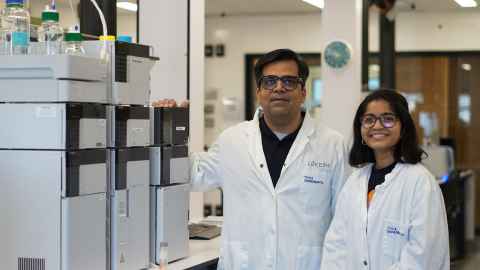New Zealand's drinking water safe from harmful ‘forever chemicals’
24 April 2024
New research shows low levels of PFAS in New Zealand’s drinking water – but caution is urged.

New Zealand's drinking water is largely free from elevated levels of dangerous “forever chemicals”, according to new research from the University of Auckland.
PFAS (per- and polyfluoroalkyl substances), or “forever chemicals”, are known for their persistence and potential health risks, including developmental effects, immune system disruption and certain types of cancer.
The New Zealand study, led by Associate Professor Lokesh Padhye from the Faculty of Engineering and Associate Professor Melanie Kah, Dr Erin Leitao, Professor David Barker and PhD candidate Shailja Data from the Faculty of Science, analysed samples from twenty locations across the country, including various suburbs in Auckland.
They found that the PFAS levels detected were below the most stringent drinking water regulations in the world, including the levels proposed recently by the US Environmental Protection Agency (US EPA).
The results from the study are “overwhelmingly positive news,” says Padhye.
Contaminated drinking water is one of the main routes for human exposure to PFAS and is a major public health concern for industrialised countries.
A study by the US EPA indicated widespread PFAS contamination in drinking water sources around the US, with many exceeding safe drinking limits.
The recent mapped data suggest Australia, China, Europe, and North America are PFAS hotspots relative to the rest of the world.
“Our findings were a pleasant surprise as the samples indicate that PFAS levels in New Zealand's drinking water are relatively low. It's a significant outcome for the community well-being of Aotearoa, especially in light of the recent global studies,” says Shailja Data, who coordinated the nationwide sampling for the study.
PFAS contamination can originate from many different sources, including industrial sites, firefighting foams, landfills, wastewater treatment plants, agricultural practices, consumer products, atmospheric deposition and food packaging. Industries using or manufacturing PFAS can release them into the environment through air, water or improper disposal.
While New Zealand lacks PFAS manufacturing sites, industries like metal plating may still contribute to contamination, says Padhye. Historical use of firefighting foams and improper waste disposal also pose ongoing risks. Due to the lack of national regulations for the manufacturing and import of consumer products, many ‘proper’ waste disposal practices can also contribute to PFAS load to the environment due to the widespread presence of PFAS in consumer products.
The researchers, who are investigating the burden of PFAS on New Zealand's environment, tested the tap water, borewell water and lake water for 30 PFAS, including regulated ones and found most PFAS below one part per trillion level.
Despite the positive findings, the research underscores the need for continued vigilance and proactive measures to safeguard the quality of New Zealand’s drinking water, they say, especially considering thousands of PFAS exist in the environment. The samples, although representative, do not capture fluctuations or long-term trends in contamination levels.
“Regular water monitoring of emerging contaminants such as PFAS is crucial in New Zealand to address water quality issues and ensure public safety. It helps identify contamination sources, assess the effectiveness of water management practices, and protect the environment and public health,” says Padhye.
Other recommendations from the research include enhancing waste management practices, regular monitoring and sharing results to quell disinformation about water quality, and conducting public awareness campaigns about water issues. Collaboration among stakeholders is also essential to address global challenges associated with emerging contaminants in water, according to the research team.
The study sampled water from the following locations: Auckland CBD, Beachlands, Beach Haven, Botany, Christchurch, Dunedin, Flat Bush, Hamilton, Mairangi Bay, Mount Maunganui, Mount Roskill, Pukekohe, Remuera, Rotorua, St Heliers, Taupō, Te Atatū Peninsula, Titirangi, Queenstown (including a lake sample) and Waiheke.
Media contact
Hussein Moses | Media adviser
M: 027 361 1000
E: hussein.moses@auckland.ac.nz